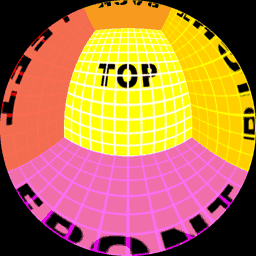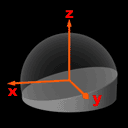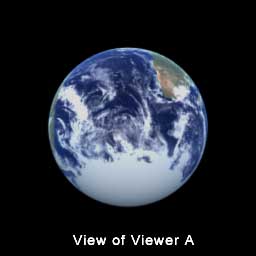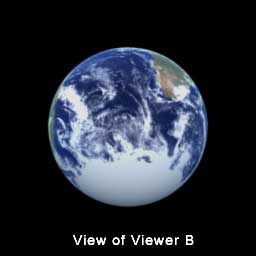
Offset of View Point
-The dome masters on this page were stitched by QuickStitcher-
Entering a tilted dome, most audiences try to take a seat in the back, or upper, rows,
although the best location to see stars in any planetarium theater is believed to be the center of the dome.
In a traditional planetarium theater, you can see a distortion-free star field only if you look up at the screen
from the center of the dome. However, since the center of the dome is occupied by the star projector,
no one can see stars from there.
There is no way of modifying the star field projected by a mechanical star projector,
but it is not difficult to make dome masters that look correctly from a given point in the dome.

EXAMPLE OF VIEW POINT OFFSET DOME MASTER
View point position: (x, y, z) = (-0.6, 0, 0)
Rearward on the center line of the dome.

Coordination System
This is the coordinate system used here.
Comparison between Normal Dome Master (left) and View Point Offset Dome Master (Right)
Offset dome masters can eliminate distortion from view of an offset viewer.
| NORMAL (NON-OFFSET) | VIEW POINT OFFSET View point position: (x, y, z) = (-0.6, 0, 0) |
|---|---|

Normal Dome Master |

Offset Dome Master |

Projected Normal Dome Master |

Projected Offset Dome Master |

View from Dome Center |

View from Dome Rear (Offset Dome Master) |

View from Dome Rear (Normal Dome Master) |
When the dome screen is shared by more than one person, it is impossible
to eliminate distortion from each one's view completely. But in large domes,
since people tend to sit in a group in the rear of the dome, it might be a good idea
to make an appropriate view point offset correction to dome masters.
In small domes, the correction is difficult because the position of each viewer
relative to the dome may vary widely. But the audience would not mind the distortion,
for they are aware that they are watching a small hemispheric screen.
Copyright 2004-2011 © PineappleWare All rights reserved.